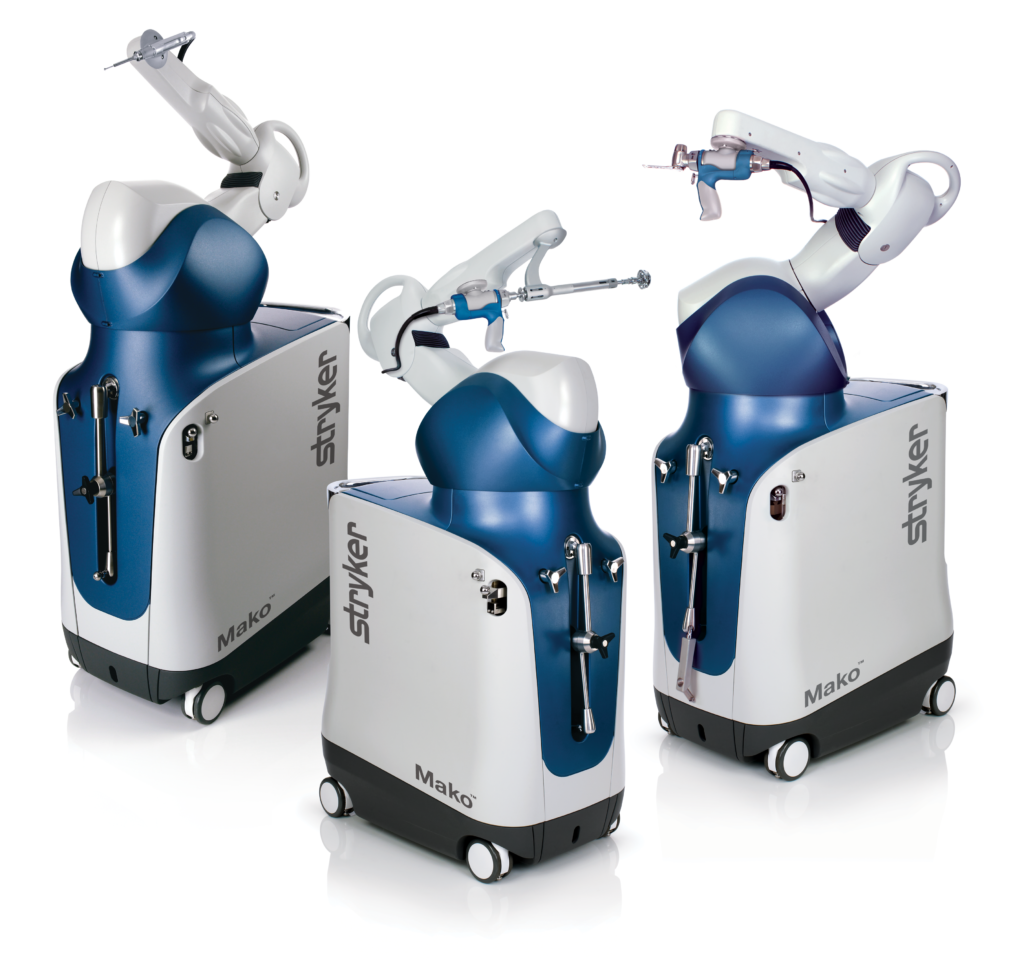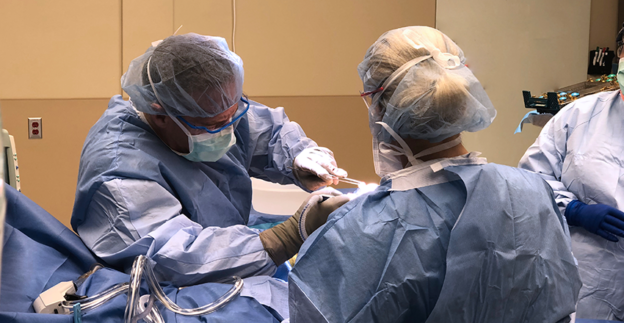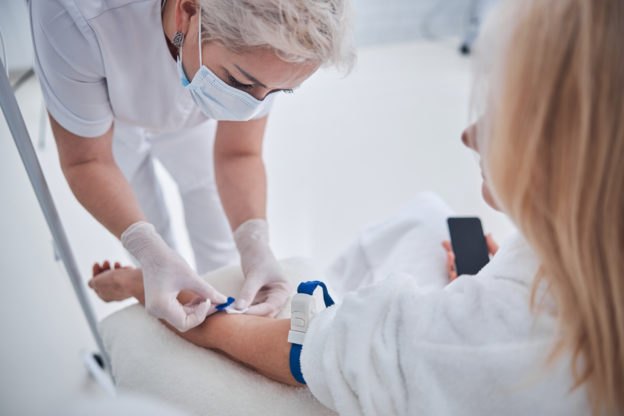FOR IMMEDIATE RELEASE
Contact: Terrie Davidson
Community Relations Manager, WCH
Office: (928) 684-3219
WCH Orthopedic Surgery Services now offering SmartRobotics™ for hip and knee surgeries.
 July 23, 2021 ‐ Wickenburg, AZ – Wickenburg Community Hospital is first hospital in the region to offer Mako SmartRobotics™. This advancement in joint replacement surgery transforms the way total knee, partial knee and total hip replacements are performed, by helping surgeons know more and cut less.1-5 *
July 23, 2021 ‐ Wickenburg, AZ – Wickenburg Community Hospital is first hospital in the region to offer Mako SmartRobotics™. This advancement in joint replacement surgery transforms the way total knee, partial knee and total hip replacements are performed, by helping surgeons know more and cut less.1-5 *
Mako SmartRobotics™ combines three key components, 3D CT-based planning, AccuStopTM haptic technology and insightful data analytics, into one platform that has shown better outcomes for total knee, total hip and partial knee patients.6-8
“With Mako SmartRobotics™, I know more about my patients than ever before, and I’m able to cut less. 1-5 * For some patients, this can mean less soft tissue damage3,4; for others, greater bone preservation.” 2,5 said Mitch Wagner, MD. “Mako’s 3D CT allows me to create a personalized plan based on each patient’s unique anatomy before entering the operating room. During surgery, I can validate that plan and make any necessary adjustments while guiding the robotic arm to execute that plan. It’s exciting to be able to offer this transformative technology across the joint replacement service line to perform total knee, total hip and partial knee replacements.”
Total knee replacements in the United States are expected to increase 189% by 2030,9 yet studies have shown that approximately 20% of patients are dissatisfied after conventional surgery.10 Mako Total Knee combines Stryker’s advanced robotic technology with its clinically successful Triathlon Total Knee System, which enables surgeons to have a more predictable surgical experience with increased precision and accuracy.11 In clinical studies, Mako Total Knee demonstrated the potential for patients to experience less pain, less need for opiate analgesics, less need for inpatient physical therapy, reduction in length of hospital stay, improved knee flexion and greater soft tissue protection in comparison to manual techniques.3,7
Mako SmartRoboticsTM for Partial Knee replacement is a treatment option designed to relieve the pain caused by joint degeneration due to osteoarthritis that has not yet progressed to all three compartments of the knee. During surgery, the surgeon guides the robotic arm during bone preparation to execute the predetermined surgical plan and position the implant. By selectively targeting only the part of the knee damaged by osteoarthritis, surgeons can resurface the diseased portion of the knee while helping to protect the healthy bone surrounding the knee joint.4 Studies have shown that robotic-arm assisted partial knee replacement, leads to greater accuracy of implant position to plan compared to manual partial knee replacement procedures.12,13

By 2030, total hip replacements in the United States are projected to grow 171%.9 Mako SmartRoboticsTM for Total Hip is a treatment option for adults who suffer from degenerative joint disease of the hip. During surgery, the surgeon guides the robotic arm during bone preparation to prepare the hip socket and position the implant according to the predetermined surgical plan. In a controlled matched-paired study to measure acetabular bone resection, results suggested greater bone preservation for Mako Total Hip compared to manual surgery.2 MKOSYM-COM-8_Rev-1_26752
“We are proud to be among the first hospitals to offer this highly advanced SmartRoboticsTM technology in our area,” said Mitch Wagner, MD, WCH Othorpedics. “This addition to our orthopedic service line further demonstrates our commitment to provide the community with outstanding healthcare.”
References:
- Banks SA. Haptic robotics enable a systems approach to design of a minimally invasive modular knee arthroplasty. Am J Orthop (Belle Mead NJ). 2009;38(2 Suppl):23-27.
- Suarez-Ahedo C, Gui C, Martin TJ, Chandrasekaran S, Lodhia P, Domb BG. Robotic-arm assisted total hip arthroplasty results in smaller acetabular cup size in relation to the femoral head size: a matched-pair controlled study. Hip Int. 2017;27(2):147-152. doi:10.5301/hipint.5000418
- Kayani B, Konan S, Pietrzak JRT, Haddad FS. Iatrogenic bone and soft tissue trauma in robotic-arm assisted total knee arthroplasty compared with conventional jig-based total knee arthroplasty: a prospective cohort study and validation of a new classification system. J Arthroplasty. 2018;33(8):2496-2501. doi:10.1016/j. arth.2018.03.042
- Hozack WJ. Multicentre analysis of outcomes after robotic-arm assisted total knee arthroplasty. Bone Joint J:Orthop Proc. 2018;100- B(Supp_12):38.
- Hampp E, Chang TC, Pearle A. Robotic partial knee arthroplasty demonstrated greater bone preservation compared to robotic total knee arthroplasty. Poster presented at: Orthopaedic Research Society (ORS) Annual Meeting; February 2-5, 2019; Austin, TX.
- Illgen RL Nd, Bukowski BR, Abiola R, et al. Robotic-assisted total hip arthroplasty: outcomes at minimum two-year follow-up. Surg Technol Int. 2017;30:365-372.
- Kayani B, Konan S, Tahmassebi J, Pietrzak JRT, Haddad FS. Robotic-arm assisted total knee arthroplasty is associated with improved early functional recovery and reduced time to hospital discharge compared with conventional jig-based total knee arthroplasty: a prospective cohort study. Bone Joint J. 2018;100-B(7):930-937. doi:10.1302/0301-620X.100B7.BJJ-2017-1449.R1
- Kleeblad LJ, Borus TA, Coon TM, Dounchis J, Nguyen JT, Pearle AD. Midterm survivorship and patient satisfaction of robotic-arm-assisted medial unicompartmental knee arthroplasty: a multicenter study. J Arthroplasty. 2018;33(6):1719-1726. doi:10.1016/j.arth.2018.01.036
- AAOS. Projected volume of primary and revision total joint replacement in the U.S. 2030 to 2060. http://aaos-annualmeetingpresskit.org/2018/research-news/sloan_ tjr/. Accessed May 9, 2018.
- Bourne RB, Chesworth BM, Davis AM, Mahomed NN, Charron KDJ. Patient satisfaction after total knee arthroplasty: who is satisfied and who is not? Clin Orthop Relat Res. 468(1):57-63. doi:10.1007/s11999-009-1119-9
- Mahoney O, Kinsey T, Mont M, Hozack W, Orozco F, Chen A. Can computer generated 3D bone models improve the accuracy of total knee component placement compared to manual instrumentation? A prospective multi-center evaluation. Poster presented at: 32nd Annual Congress of the International Society for Technology in Arthroplasty (ISTA); October 2-5, 2019; Toronto, Canada.
- Bell SW, Anthony I, Jones B, MacLean A, Rowe P, Blyth M. Improved accuracy of component positioning with robotic-assisted unicompartmental knee arthroplasty: data from a prospective, randomized controlled study. J Bone Joint Surg Am. 2016;98(8):627-635. doi:10.2106/JBJS.15.00664
- Lonner JH, John TK, Conditt MA. Robotic arm-assisted UKA improved tibial component alignment: A pilot study. Clin Orthop Relat Res. 2010;468(1):141-146. doi:10.1007/s11999-009-0977-5
***



